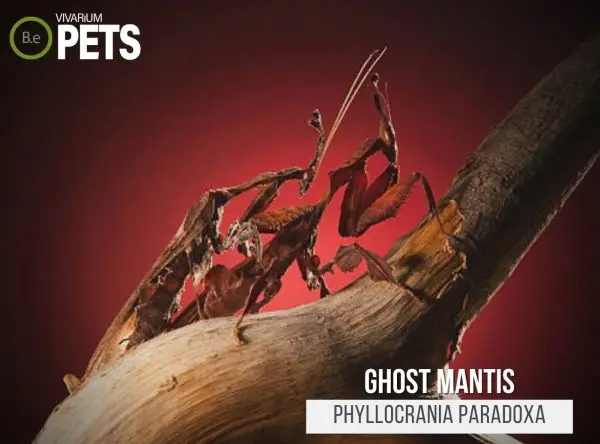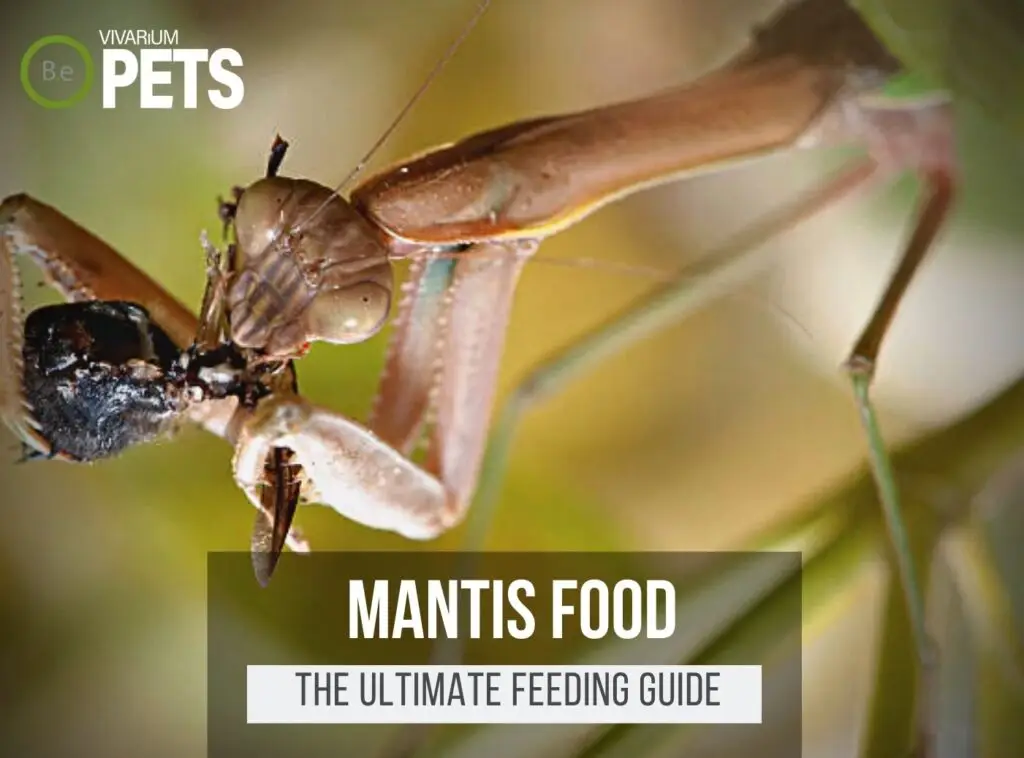Are you thinking of getting a Ghost Mantis as a pet?
This beginner’s guide to caring for Phyllocrania paradoxa will help you properly nurture your tiny new friend from the first day you bring it home.
We’ll cover the essentials like lifespan and nutrition, discuss how to create an ideal environment and arm you with tips for avoiding some common problems.
| Characteristics: | |
|---|---|
| Common Name | Ghost Mantis |
| Family Name | Mantidae |
| Scientific Name | Phyllocrania paradoxa |
| Use | Pets |
| Temperament | Non-aggressive |
| Lifespan | 8 to 12 Months |
| Diet | Insectivore |
| Adult Size | 2 in |
| Breeding Type | Egg Layer |
| Care Level | Moderate |
| Minimum Tank Size | 5 Gallon |
| pH | 6.0-7.0 |
| Hardness | Moderate |
| Temperature | 63-90°F |
What Are Ghost Mantis?
Ghost Mantis is a species of colorful, and very small tropical praying mantis from the family Mantidae.
Though Native to Central and West Africa, they are now found almost anywhere in the world due to the pet trade.
Ghost Mantes grow to an average size of a few inches in length and are shy but hardy, making them a great choice for a first-time pet praying mantis.
What Do Ghost Mantis Look Like?
Phyllocrania paradoxa range in length from 1.5 to 2 inches and possess a unique coloration of yellowish-brown and grey.
Their long antennae and two legs measuring around three times their body length, help them blend into their natural environment.
These critters are covered in wrinkled sheets all over their body, giving them an almost leaf texture.
Along the top of its head are two pronounced spines, while the legs are lined with tiny spines.
The Ghost Mantis has large eyes and compound eyes on the sides of their heads.
Benefits Of Using Ghost Mantis
Ghost Mantis is often used in vivariums like terrariums or paludariums due to their ability to act as both pest controllers and decorations.
They are renowned for their low-maintenance care requirements and their ability to tolerate and thrive in a wide range of temperatures.
As carnivorous predators, Phyllocrania paradoxa feeds on various small insects in the enclosure, which helps to keep the other animals healthy by reducing the number of pests.
micro-ecosystems also provide a safe and conducive environment for breeding and raising the mantis.

Ghost Mantis Facts
Phyllocrania paradoxa is a small insect that inhabits dry, warm climates in Africa.
Their diet is primarily small insects and they are considered to be quite docile and low-maintenance pets.
With proper care, Ghost Mantis can have an average lifespan of several months, and can even be bred in captivity.
Habitat
Phyllocrania paradoxa is a species of praying mantis that is native to tropical areas of Africa.
They typically inhabit densely-vegetated areas like the rainforest, jungles, and savannas where there are plenty of flowers, plants, and other insects to hunt.
Ghost Mantis have been known to adapt well to some urban environments as well.
Diet
In its natural habitat, P. paradoxa mainly feeds on small insects like moths, beetles, and flies.
They wait in ambush for their prey to come close enough to be snatched up by their well-developed raptorial forelegs.
They are also known to eat smaller mantis species.
Temperament
Ghost Mantis are usually quite passive when it comes to interacting with humans and other animals.
Although they are capable of biting, they typically don’t display aggressive behavior.
With regular handling, they can become used to being around people and animals.
If Phyllocrania paradoxa feels threatened, their natural instinct is to try to escape rather than lash out.
Lifespan
Ghost Mantis has a lifespan of about 8 to 12 months, depending on habitat and nutrition.
They have three stages in their life cycle, starting from an egg.
When they hatch, they enter the first stage as a nymph.
The nymphs go through several molting phases and morph into adulthood in the final stage.
As adults, Ghost Mantis usually die at the end of the summer, though they can live for a few months after.
Good nutrition and a healthy environment are essential if you want P. paradoxa to live its full lifespan.
Breeding
Ghost Mantis reproduce by laying ootheca, which is a protective egg capsule that typically contains hundreds of eggs.
Female mantis can produce up to 6 oothecae in their lifetime. After the ootheca is produced, it can take up to 8 weeks for the eggs to hatch.
Young nymphs typically emerge during the warmer months of spring and summer.
If conditions are ideal, the young nymphs can reach adulthood in as little as 4 months.
Males and females will typically mate in the same way as praying mantises, with the male gripping onto the female’s back.
During the mating process, the female will usually take a few bites out of the male’s head.
This behavior isn’t unusual to the male and is simply nature’s way of making sure the female is satisfied with the partner she has chosen for reproduction.
Once the mating process is complete, the female will begin creating the protective ootheca to lay her eggs.
After the eggs have hatched, the cycle will start all over again as the Ghost Mantis nymphs mature and begin to mate.
Where To Find Ghost Mantis
Phyllocrania paradoxa is found in a variety of sub-Saharan countries, including Congo, Uganda, Tanzania, and Benin.
They can traditionally be found in dry savannahs and forests, and can sometimes be spotted on tree branches.
For those looking to buy Ghost Mantis, there are many vendors online.
Make sure to purchase from a vendor with impeccable reviews, as you want to ensure that your new pet has been sustainably sourced and properly cared for.
It’s also vital to check for parasites before introducing the mantis to your home.
Lastly, if you’re considering wild-captured Ghost Mantis, it’s good practice to note that this can be dangerous and damaging to the environment.
Capturing critters from the wild can disrupt populations, and transferring wild critters can introduce unwanted pests into your home.
Wild capture is strictly discouraged.
Ghost Mantis Care
To care for a Phyllocrania paradoxa properly, provide an appropriate habitat, and balanced nutrition, and pay attention to common problems such as dehydration, overfeeding, and pest infestations.
Following these guidelines will help ensure the most optimal lifespan for your Ghost Mantis.
Tank Requirements
The ideal tank for a Ghost Mantis is a vivarium with tall sides and a mesh lid to provide excellent ventilation.
The tank should be kept clean with regular maintenance of the substrate.
The ideal pH for the tank should be 6–7, Hardness <5, and Temperature between 63°F – 90°F (17°C – 32°C).
The substrate used should be loosely packed and soft such as terrarium sand, peat moss, or coco fiber soil.
Lastly, the terrarium lighting should be natural or simulated.
The tank should have a photoperiod of 12 hours for natural light and 12 hours off, while for artificial lighting, you should provide 14 hours on and 10 hours off.
What Does Ghost Mantis Eat?
Feeding Phyllocrania paradoxa is a critical part of caring for them effectively.
Luckily, you have a few options when it comes to providing them with the nutrition they need to stay healthy.
Here’s a quick guide on how to feed your Ghost Mantis:
- Provide a balanced diet of small insects such as fruit flies, crickets, spiders, and other small bugs.
- Depending on its size, a mantis may require 1-2 insects per day.
- Any leftover food should be removed to avoid overfeeding and the spread of disease.
- To supplement the diet, you can also provide a nutrient-rich powder or gel that you can sprinkle or squeeze onto the mantis’ food.
- Ensure a clean and safe environment by removing any debris and uneaten food.
Following these tips will help ensure that your praying mantis has a nutritious and balanced diet.
If you’re looking for a more detailed approach to feeding these critters, be sure to check out my ultimate DIY Praying Mantis food guide. I give a more in-depth explanation of the best foods and my favorite recipe.
Best Tankmates For Ghost Mantis
Phyllocrania paradoxa do best in tanks with tankmates that share similar beneficial qualities. Some good tank mates include:
- Land Hermit Crabs: These small nocturnal crustaceans help keep the tank’s substrate clean by scavenging the bottom for tasty morsels, while they and the mantis will not compete for food.
- Isopods: True to their name, isopods are insect-like organisms that can mimic some of the natural behaviors of the mantis. They are beneficial to the overall health and vitality of the Ghost Mantis’s environment.
- Springtails: These small, harmless critters can help reduce mold growth in the tank, are harmless to the P. paradoxa, and consume organic waste to help balance the tank’s environment.
Overall, paired with the proper care and environment, these harmless tankmates can help keep your praying mantis active.
Conclusion
In conclusion, providing the correct care for your Phyllocrania paradoxa is essential to keeping it healthy and active.
Understanding tankmates, diet, environment, and a few common problems can help you create the ideal living conditions for your mantis.
With a little research and a lot of love, you and your Ghost Mantis will have a long and enjoyable relationship.
Frequently Asked Questions
No, ghost mantis (Phyllocrania paradox) are native to West and Central Africa.
Yes, ghost mantises (Phyllocrania paradox) are typically friendly and have gentle dispositions, making them suitable for those seeking a pet insect.
Adult ghost mantises (Phyllocrania paradox) can reach lengths of 1 to 2 inches.
Yes, ghost mantises (Phyllocrania paradox) are fairly easy to care for, requiring a humid environment with temperatures from 63 to 90°F. They also must be fed live insects such as fruit flies, small crickets, or other small bugs.
Ghost mantises (Phyllocrania paradox) should be fed regularly, up to once a day for adults. You may want to feed your mantis more frequently as it grows.

